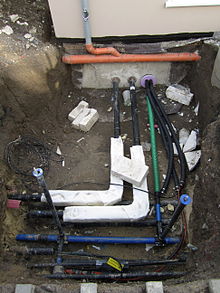House connection

The connection point between the electricity , district heating , water , sewage and gas lines , the supply or disposal company and the lines of the consumers or the house connections is called the house connection .
description
The house connection includes the branch on the supply network outside the building, the wall duct on the building ( house entry ) and the lines up to the main fuse or main shut-off device inside the building. The wall penetration is done by means of a core drill hole or a casing pipe. The supply lines enter the building through this. These entries (penetrations) of the supply lines through the external surface sealing must be gastight and watertight in accordance with DIN 18195 (building waterproofing) as well as DIN 18322 (underground civil engineering works), DIN 18366 (sealing work) and other standards. Therefore, tested and DVGW-certified single and multi-line building entries (MSH) that do not automatically connect to the external surface sealing are common today. If necessary, these connections can be made separately or by alternative solutions that are customary today with automatic centering and automatic, pressure-water-tight connection to each external surface seal.
While each medium can be introduced independently of one another at different points in the building with single-line building entries, with an MSH several or all supply lines are transferred centrally to one point in the house connection room. The supply lines can run through empty pipes in the ground. This means that they can be replaced at any time without excavation work.
For a new building project, the feasibility of the necessary house connections must be clarified with the responsible utility company in advance. At the latest upon completion, an application for the construction of the house connection must be submitted, which can be carried out by the municipal utility or a commissioned company.
Electricity connection
In Germany, DIN 18015-1 “Planning of electrical systems in residential buildings” regulates the specifications of electrical house connections. The standard assumes a power requirement of 14.5 kW for a residential unit with conventional building services ; if there is electrical hot water, 34 kW.
In Germany nowadays (2012) the house connection is usually carried out by a three-phase underground cable that ends in a house connection box and is supplied by a main line branch. The connection is dimensioned so that overcurrent protection devices with a rated current of at least 63 A can be assigned to protect against overload . Overhead line connections can be smaller. The distribution network operator decides on the actual dimensioning of the house connection fuses . The dimensioning is usually lower, from 3 × 40 A for a single-family house without electrical hot water preparation.
FTTH connection for Internet
Since January 27, 2016 it has been mandatory in Germany under the DigiNetz Act to connect all buildings in new development areas using FTTB or FTTH (Fiber to the building / home) (see picture above). The Federal Ministry of Transport and Digital Infrastructure is prohibited from laying copper lines alone .
District heating and water supply and disposal
The term house connection is also used in connection with the water and district heating supply and the sewage and rainwater pipes of a house. Almost every house is connected to the sewer system , into which it discharges sewage . All sewer pipes unite underground within a property, lead to the sewer system and are accessible from an inspection shaft. From there it is possible to check and clean the sewage pipe without having to carry out construction work. Outside the building, a frost-free installation of the line pipes must be ensured.
photos
literature
- Winfrid Hauke, Rolf Thaele, Günter Reck: RWE Energie Bau-Handbuch. 12th edition, Energie-Verlag GmbH, Heidelberg 1998, ISBN 3-87200-700-9
See also
Web links
Individual evidence
- ↑ Werner Baade: Electrical systems in residential buildings. 2007, accessed October 10, 2016 .
- ↑ AB for the network connection of end consumers in low voltage according to § 20 N AV ( Memento of the original dated December 6, 2013 in the Internet Archive ) Info: The archive link was automatically inserted and not yet checked. Please check the original and archive link according to the instructions and then remove this notice. (PDF), see 5.5. Overhead line house connection, Enervie AssetNetWork GmbH, February 1, 2010, accessed December 3, 2013
- ↑ MitNetz electricity, July 2012: TAB NS Central Saxony called December 3, 2013
- ↑ Federal Ministry of Transport and Digital Infrastructure (BMVI). DigiNetz law [1]
- ^ Meeting of Netzallianz Digitales Deutschland . Speech by Minister Dobrindt on the ban: Minute 4: 00-5: 50 in [2]




